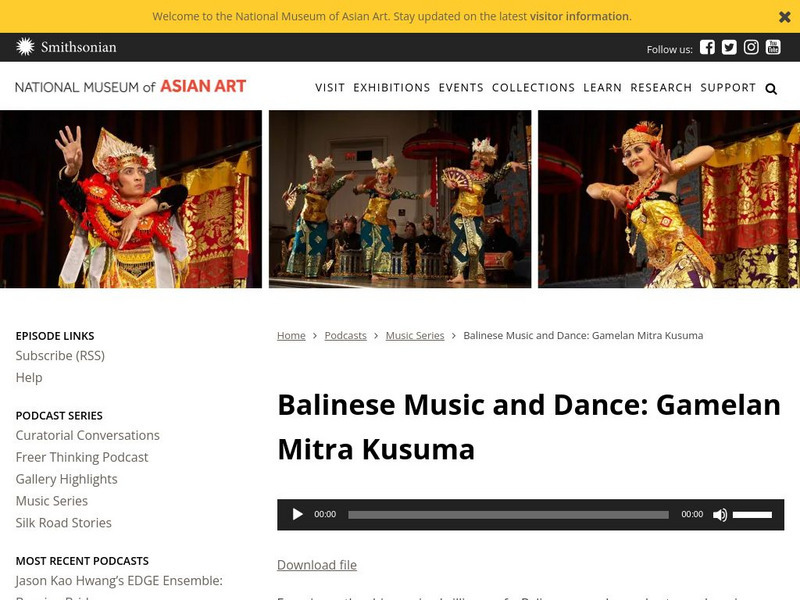Smithsonian Institution
National Museum of Natural History: Qrius: How Fossils Explain the Rise of Dinosaurs
Find out how this paleontologist believes dinosaurs rose to higher grounds following a mass extinction hundreds of thousands of years ago. [36:38]
Smithsonian Institution
National Museum of Natural History: Qrius: Forensic Anthropology Bone Whispering
This forensics anthropologist probes into the stories bones can tell about the environment, the life and the death of the past. [29:15]
Smithsonian Institution
National Museum of Natural History: Qrius: Exploring the Solar System With Antarctic Meteorites
How can meteorites teach us about the early solar system? Check out this webcast with Dr. Cari Corrigan as she shares her discoveries from meteorites that landed in Antarctica. [34:48]
Smithsonian Institution
National Museum of Natural History: Qrius: Volcano Geochemistry Windows to Earth's Interior
Geologist Dr. Elizabeth Cottrell, describes why she considers volcanoes "lungs of the earth" in this webcast. [29:15]
Smithsonian Institution
National Museum of Natural History: Qrius: Adaptations Inside the Insect Zoo
This webcast relates the research being done to understand the adaptations insects and other arthropods make to survive in various conditions. [29:15]
Smithsonian Institution
National Museum of Natural History: Qrius: Bird Extinctions Time Travel Through Lava Tubes
Dr. Helen James, an ornithologist at the National Museum of Natural History, explains what prehistoric evidence can tell you about bird extinctions. [29:15]
Smithsonian Institution
National Museum of Natural History: Qrius: Ecosystem Change Plotting With Plant Collections
Plants are a resource that can help scientists measure change. This webcast digs into how plant specimens are studied to better understand ecosystem changes. [29:14]
Smithsonian Institution
National Museum of Natural History: Qrius: Forensic Ornithology Bird Detective
An ornithologist from the National Museum of Natural History shares her research studying birds that have been struck by airplanes. Find out what can be learned from these studies. [27:45]
Smithsonian Institution
National Museum of Natural History: Qrius: Living Together Parasites and Hosts
Investigate how important parasites are and how they relate to their hosts through this webcast with Dr. Anna Phillips, a zoologist. [30:52]
Smithsonian Institution
National Museum of Natural History: Qrius: Ocean Biodiversity Discovering Marine Invertebrates
A zoologist discusses her research looking for new invertebrates in the seas. She also gets to name the new creatures! [29:16]
Smithsonian Institution
National Museum of Natural History: Qrius: Global Change Reading Ocean Fossils
In this webcast, Dr. Brian Huber, paleontologist, explains why tiny organisms called foraminifera are great indicators of changes in global environmental conditions. [29:16]
Smithsonian Institution
National Museum of Natural History: Qrius: Mass Extinction Solving the Dinosaur Mystery
Dinosaurs were not the only life to go extinct and leave a trail to their history. This webcast presents a paleobotanist who has studied extinction at a site in North Dakota. He discusses mass extinction. [29:16]
Smithsonian Institution
National Museum of Natural History: Qrius: Paleobotany Climate Change Past and Present
A webcast features a paleobotanist who has studied the climate record through fossilized leaves and other remnants of history. [29:15]
Smithsonian Institution
National Museum of Natural History: Qrius: What Tiny Fossils Explain About Big Dinosaur Ecosystems
A webcast presents a way to dig deeper into the ecosystems from dinosaur eras based on data gathered from small fossils versus what big dinosaur bones may reveal. [36:40]
Smithsonian Institution
National Museum of Natural History: Qrius: Culture and Climate Change in the Arctic
This webinar probes into how people in the Arctic have coped with extreme conditions for thousands of years. [35:35]
Smithsonian Institution
National Museum of Natural History: Qrius: Mummy Science Natural and Cultural Preserved Remains
How can modern science help unravel the history of mummies? Compare human-made mummies with naturally made mummies. [29:16]
Smithsonian Institution
National Museum of Natural History: Qrius: Unseen Connections a Natural History of the Cellphone
A webcast examines the history of the cellphone and the revolution they've created in communication. [29:16]
Smithsonian Institution
Smithsonian Science Education Center: Fired Up About Energy
Did you ever want to see inside your student's minds while you are teaching a concept? Through this video, you can see the common assumptions student's hold about energy and how you can build on these ideas to explain the Law of...
Smithsonian Institution
Freer | Sackler Galleries: Balinese Music and Dance: Gamelan Mitra Kusuma
Podcast of traditional and contemporary music and dance of Bali performed by a gamelan orchestra. Includes detailed notes as well as a slideshow of Balinese performers. [55:16]
Smithsonian Institution
National Museum of American History: Transportation Infrastructure Videos
Videos from the America on the Move exhibition provide an overview of America's transportation infrastructure history, the road and rail networks we depend on.
Smithsonian Institution
National Museum of Natural History: Qrius: What Tiny Marine Fossils Reveal About Extinction
What makes a species likely to go extinct? What makes some species stick around longer than others? This webcast will investigate these questions. [31:30]
Smithsonian Institution
Hirshhorn Museum Podcast: Associate Curator Evelyn Hankins on Alexander Calder
Learn about the work of Alexander Calder in the collection of the Hirshhorn Museum in Washington D.C., in this podcast of curator Evelyn Hankins discussing the Calder's work. [15:35]
Smithsonian Institution
Smithsonian American Art Museum: Meet Sam Gilliam
The Luce Foundation Center at the Smithsonian American Art Museum is made possible through a generous gift of the Henry Luce Foundation and presents thirty-five hundred art and craft objects from American Art to the public. This short...
Smithsonian Institution
National Museum of Natural History: Qrius: Island Biodiversity Tracking Human Influences
How do inhabitants on islands alter the ecosystem over time? An archaeologist will identify specific changes over many years that occurred as a result of human arrival on islands. [29:16]





